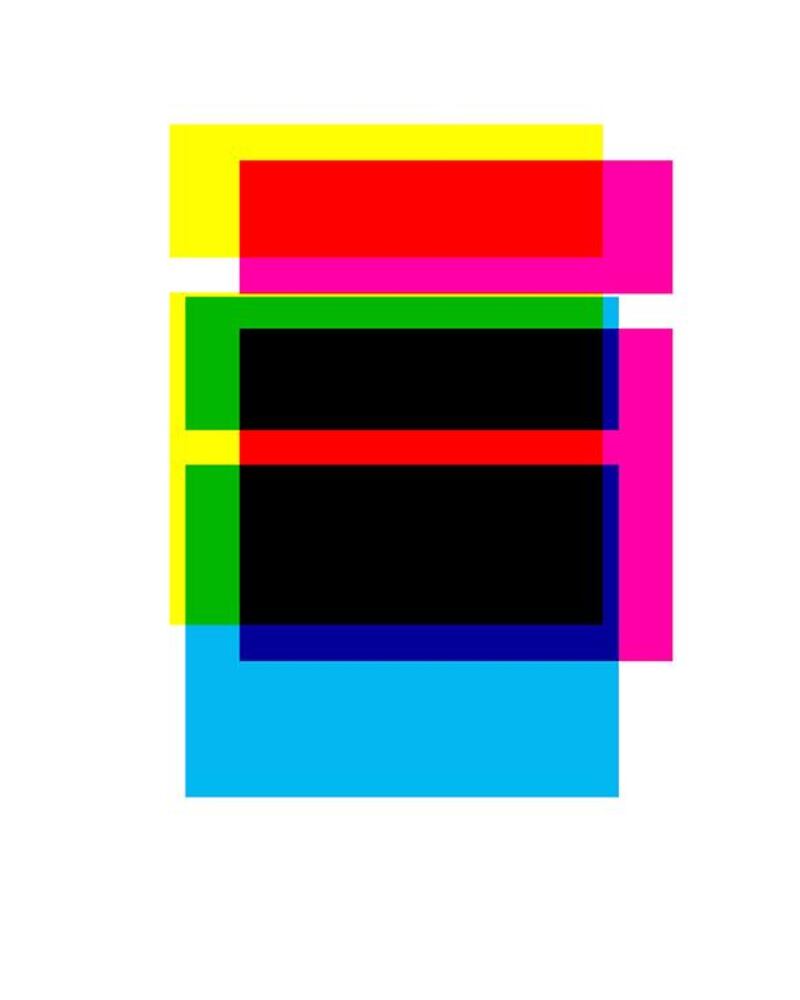Black is an absence of colour or an amalgamation of all colours. Either way, it is not a colour in its own right. It is this scientific mystery that fascinated the artist Hamra Abbas, a topic on which she spent months, searching for a way to visually represent it.
The result is the namesake piece of her latest exhibition currently showing at Lawrie Shabibi gallery in Dubai's Alserkal Avenue, Kaaba Picture as a Misprint.
The show is the first time Abbas has returned to Dubai since being one of the Abraaj Capital Art Prize winners in 2011 and winning the Jury Prize at the Sharjah Biennial in 2009.
Taking the black cube of the Kaaba, the most sacred and central point of Islam situated in the holy mosque in Mecca, down to its most basic geometric form of two rectangles, Abbas digitally created three images in cyan, magenta and yellow – the three colours used in all printing processes – and laid them on each other so that they created black.
“It was like an epiphany of sorts,” explains the Pakistani artist, who divides her time between Lahore, Pakistan, and Boston, United States. “I had been trying to find a way to show how black is the combination of all colours for some time and then I came across a particular Bauhaus book design that quickly showed me the direction. It was magical, if I may say so.”
In theory, black is formed by the convergence of the three primary colours, so in a way, the colour black is not actually black, she says, it is simply an alignment of colours and that is why “the piece is so mysterious, because the black that you see is not there”.
Quite clearly questioning the notion of faith and the very intangibility of all the steady constants that govern the philosophies of any religious practice, the six prints that make up the Misprint series are powerful pieces and once seen in the context of the entire show, they become all the more interesting.
Kaaba Picture as a Misprint came after Abbas spent almost a year researching and collecting images and memorabilia of daily life in her native Pakistan, where she visited her family home as well as the homes of the urban middle class, observing and taking pictures.
When she returned to her Boston studio, she was struck by the frequency of the appearance of the image of the Kaaba in various forms.
“I was fascinated to see the representations of the Kaaba depicted in a spectrum of colours, on prayer rugs, plates, wall hangings and other decorative items. To start thinking about or conceptualising it was electrifying,” Abbas says.
The first step was to create seven different images titled Kaaba Pictures, a series commissioned for and first exhibited at the 2013 deCordova Biennale.
They are actually large-scale photographs of miniature paintings that Abbas did of the different representations of the Kaaba. And it was this line of thought that led her to consider the colour black and all its mysteries.
She finally labelled her method as misprint, referring to the printing mistakes that used to happen frequently with offset printing in the pre-digital age, but also with more metaphysical connotations. “The artist links the quest for truth through religious devotion with the many ways in which that truth can be understood,” explains the gallery in a statement.
Also featured in the exhibition is Wall Hanging 1, a piece that was installed on the facade of the Isabella Stewart Gardner Museum in Boston earlier this year.
It depicts a plaster cast of the gold curtain that hangs on the Kaaba but at a skewed angle. Abbas found the cast, as pictured, on the wall in her mother’s house. Discussing it with her husband, she began philosophising about objects of religious significance being left in a neglected state.
“It is suggestive of the gap between theory and practice; that is, an object’s textual references may not always correlate with how it functions in the everyday. Moreover, I imagined it like a door that cracks open – as a wedge between two spaces to suddenly offer a glimpse of, or insight into, something beyond. After that I started spotting religious pictures showing signs of neglect everywhere.”
Abbas's newer series of humorous, yet technically considered pieces, is called Artists.
They are portraits of famous artists made from polymer clay or Plasticine-like material in a very rudimentary manner, which goes against all of Abbas’s formal training.
Bearing resemblance to Abbas's former series titled Idols, the photographs elevate these famous artists – Marina Abramovic, Joseph Beuys, Louise Bourgeois – to a quasi-religious status and thus question that status as well as their identity.
• Hamra Abbas: Kaaba Picture as a Misprint runs until May 27 at Lawrie Shabibi gallery. For more information, visit www.lawrieshabibi.com
aseaman@thenational.ae





